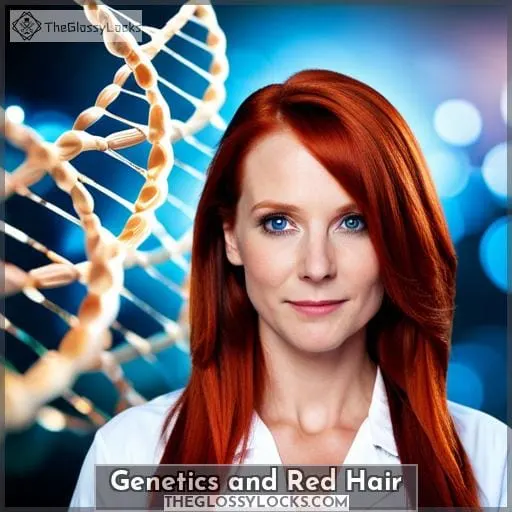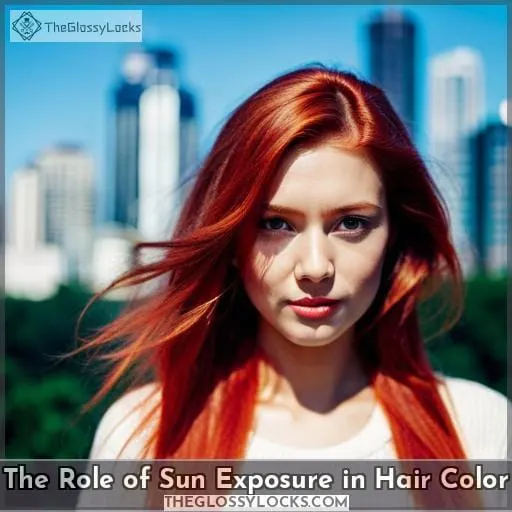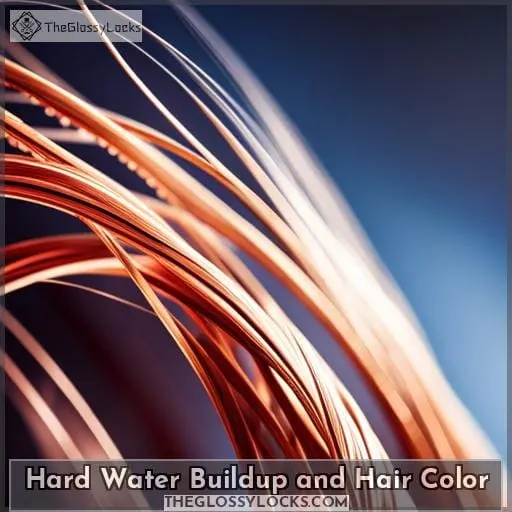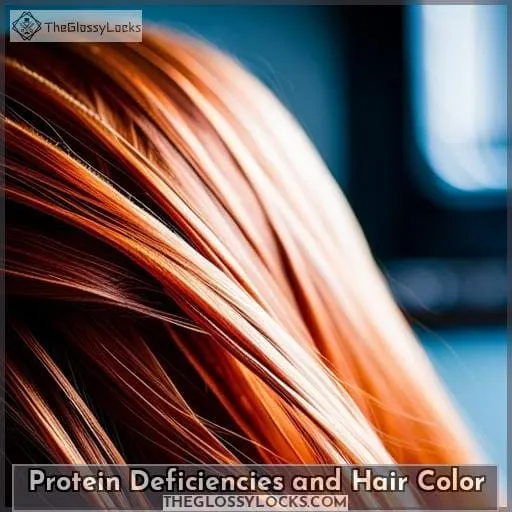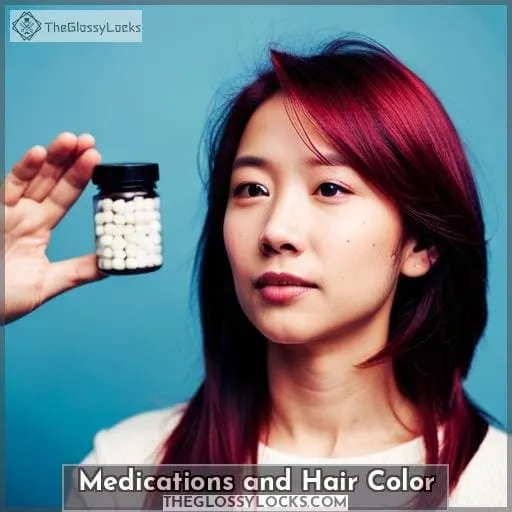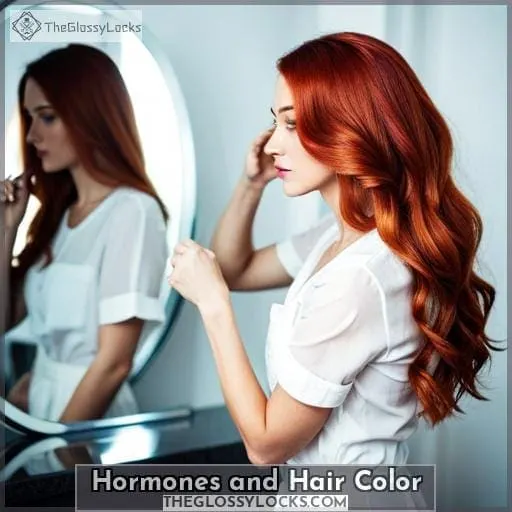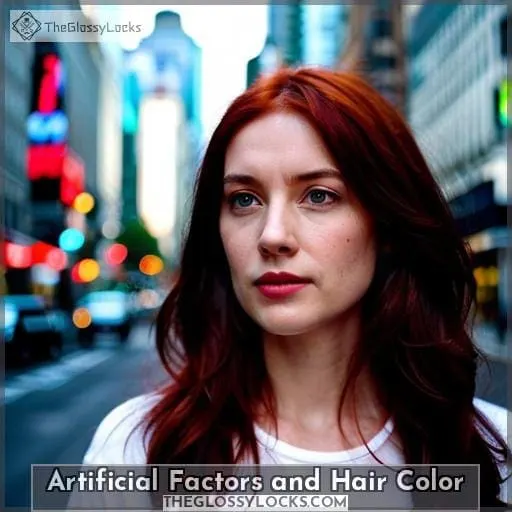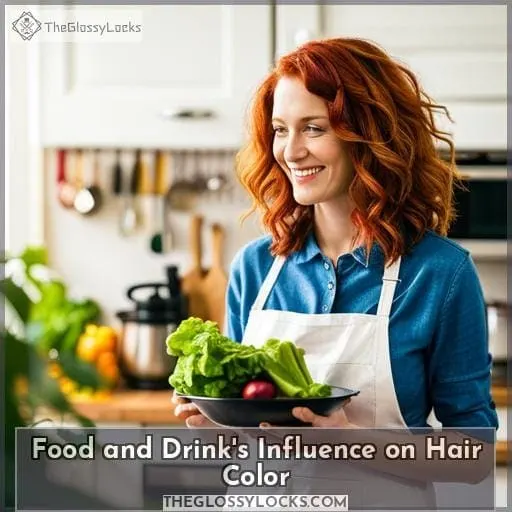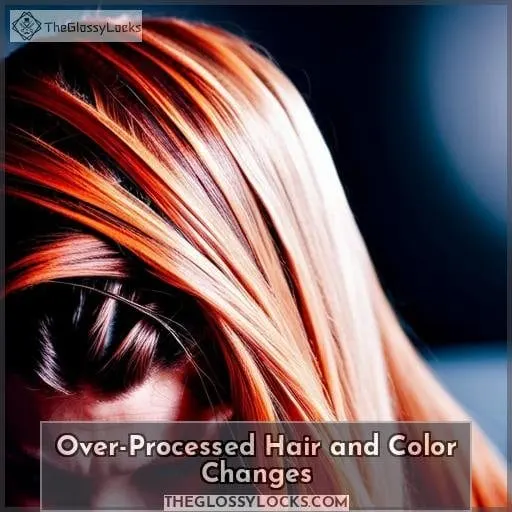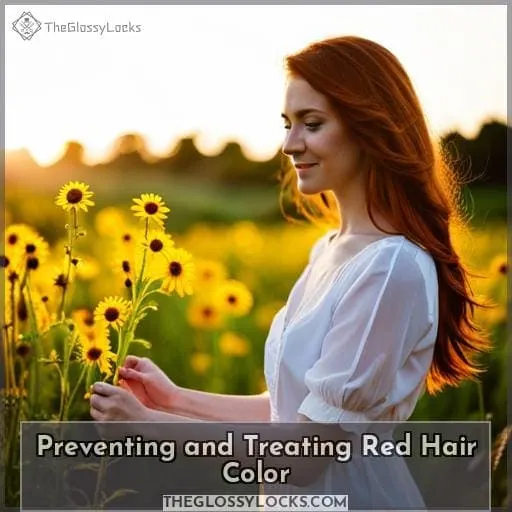This site is supported by our readers. We may earn a commission, at no cost to you, if you purchase through links.
Are you concerned about why your hair is naturally turning red? You’re not alone. Many people find themselves wondering the same thing, and it can be a little disheartening. But don’t worry – there are many potential causes for this change in color, as well as ways to prevent it from happening or reverse its effects if necessary.
Table Of Contents
- Key Takeaways
- Genetics and Red Hair
- The Role of Sun Exposure in Hair Color
- Hard Water Buildup and Hair Color
- Protein Deficiencies and Hair Color
- Medications and Hair Color
- Hormones and Hair Color
- Artificial Factors and Hair Color
- Food and Drink’s Influence on Hair Color
- Over-Processed Hair and Color Changes
- Preventing and Treating Red Hair Color
- Frequently Asked Questions (FAQs)
- Conclusion
Key Takeaways
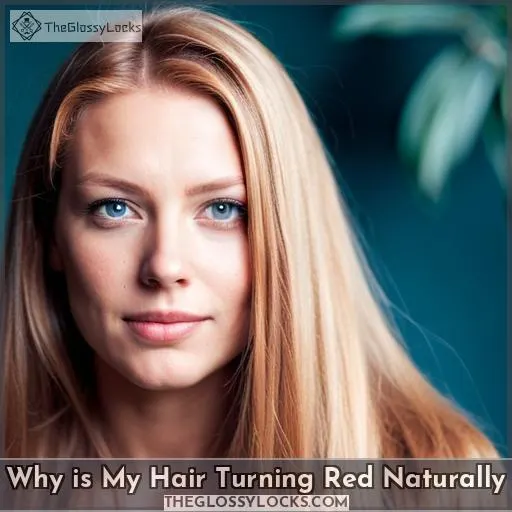
- Genetics, stress factors, sun exposure, and certain medications can cause natural hair to turn red.
- Overuse of chemical products, hard water buildup, protein deficiencies, and hormonal imbalances can also lead to changes in hair color towards the red spectrum.
- Prevention measures include using color-safe products, protecting hair from environmental stressors, and maintaining a balanced diet with vitamin B12 and copper-rich foods.
- Treatment options include plant-based coloring agents, seeking professional assistance, using color-correcting products, and dyeing hair to restore natural hues or neutralize unwanted tones. Iron supplements and protective styling may also be recommended.
Genetics and Red Hair
You may be wondering why your hair is turning red naturally. Genetics can play a role in the production of red hair, but there are other potential causes to consider as well. Dietary iron intake, stress factors, and melanin production can all contribute to changes in natural color or a reddish hue appearing on dark or light colored hair.
In addition, certain medications and deficiencies such as pernicious anemia could also cause your locks to change hues over time. Hair dyeing processes like bleaching that damage the follicle may also lead to undesired colors emerging from strands when they grow out again later on down the line too.
To get back more of your natural coloration, it would be wise for you to take some proactive preventive measures. For example, installing a showerhead filter if hard water buildup is present can prevent further discoloration.
Eating foods rich with vitamin B12, which has been linked with helping restore pigment levels, can also be helpful. Taking steps like wearing hats or scarves when outdoors so sunlight doesn’t accelerate any existing issues either can also be beneficial.
If these measures don’t help, seeking professional assistance might be necessary.
The Role of Sun Exposure in Hair Color
When it comes to hair color, the sun plays an important role. Sun exposure reveals hidden red undertones in black and brown hair, as well as turns blonde locks green or gives darker hues a reddish hue.
Additionally, long-term overexposure to UV radiation can lead to melanin loss and result in unexpected changes of your natural hair color from brown or black turning into fiery red.
If you notice that your mane is starting to take on a new shade due to its prolonged direct sunlight contact, make sure you protect yourself with sunscreen when outdoors for more than 15 minutes at once! The same goes for those who are prone to developing higher iron levels.
It’s worth mentioning that high levels of stress don’t do much good either since it affects scalp health leading to visible consequences like thinning out strands and premature graying, but also sudden changes in their original pigment, such as appearing reddish.
On top of all these factors playing a part together, there are still artificial causes such as overuse of chemical products like dyes or bleaches. Even heat styling techniques have been known for causing similar issues when done excessively without proper protection against damage – always use temperature control tools! All these influences may be difficultly reversible unless professional help is sought after.
So before any dramatic alteration takes place, consider taking preventive measures such as using leave-in conditioners, serums designed specifically for colored hairs, etcetera.
The most convenient way, however, seems always to be dyeing back towards the desired tone. Although having regular haircuts might help preserve existing colors naturally by allowing them to spread evenly throughout the length instead of piling up near roots only.
Hard Water Buildup and Hair Color
Hard water buildup can change your hair color, giving it a reddish hue. This is because hard water often contains high levels of iron and other minerals that can build up on the scalp over time. When this happens, white hair may start to appear, as well as red or rusty tones in dark brown or black hair.
Regular maintenance and using color-safe products are key to preventing these changes from occurring due to hard water buildup.
Sun protection is also important for maintaining healthy locks. Exposure to UV rays causes melanin production in the body, which could lead to an increase of copper deposits under the skin resulting in red hues appearing within darker shades of tresses.
To keep your locks looking their best while avoiding any unwanted pigment changes due to protein deficiencies, iron overloads, or sun damage:
- Install a showerhead filter if you live in an area with lots of hard water.
- Eat a balanced diet rich in vitamin B12 and copper-rich foods.
- Wear protective hats/scarves when out enjoying sunny days.
- Use products specifically designed for colored strands and avoid strong chemical treatments such as bleach/dyeing.
Taking some simple steps now will ensure that you maintain lusciously vibrant locks without worrying about premature graying or unexpected shifts toward the ruddiness spectrum caused by environmental factors like prolonged sun exposure combined with regular use of harsh styling tools!
Protein Deficiencies and Hair Color
Protein deficiencies can cause your hair to take on a reddish hue. When the body does not receive enough protein, it can lead to a range of symptoms such as fatigue and weakness. This deficiency also affects the production of melanin, which is responsible for giving hair pigment its color.
Iron-rich diets contribute to this problem as they create high concentrations of cleaning ingredients in the scalp that reduce melanin production levels further. This may make your hair appear redder than it would without these substances present.
Kwashiorkor is another medical condition caused by protein deficiency which results in reddish or brown skin tones along with other symptoms like swelling around joints and organs, stunted growth, poor digestion, and vision problems among others.
To prevent unwanted changes due to lack of proteins, you should consider eating foods rich in iron and B12 vitamins, controlling stress levels, and maintaining proper sun protection using hats or scarves when outdoors.
Wearing protective clothing that has UPF technology and adding certain nutrients into your diet if needed can also help.
Be sure to use color-safe products while styling your locks. Look out for those containing moisturizers so you won’t dry out any further hairs already affected by low proteins. Avoid over-washing them as well because shampoos usually contain high concentrations of cleansing ingredients.
Keep up good hygiene habits but don’t overly rely on products since some medications like birth control pills could affect existing natural pigmentation too. Instead, try focusing more on a unique haircare regimen tailored specifically to your needs.
Medications and Hair Color
Certain medications can drastically alter your hair color, giving it a reddish hue. From hormones to anemia and iron levels, there are many factors that may contribute to this change in color.
Here is a list of five things you should consider if your hair has turned red:
- Cleansing products – Many shampoos contain harsh chemicals that can strip away natural oils from the scalp and lead to discoloration.
- Balancing Iron Levels – Low iron levels can cause red or rusty tinted hair due to a lack of proper nutrition needed for healthy growth and pigment production. Eating foods high in copper such as dark leafy greens, nuts, seeds, beans, or eggs will help keep nutrient stores balanced within the body, aiding in restoring normal pigmentation back into the strands over time with regular intake.
- Stress Effects – Chronic stress causes inflammation throughout the body leading up to increased cortisol hormonal activity, which decreases melanin production resulting in lighter colored locks like blonde tones turning into reddish hues instead! Taking steps towards reducing stress through yoga, meditation, breathwork, etc.
can be helpful when trying to achieve more even tonal changes over time naturally without any extra effort on styling methods. - Hair Dyes – Artificial dyes containing ammonia or other bleaching elements used too often result not only in dryness but also unexpected changes with overall shade like darker brunettes going towards ginger shades becoming much brighter than before intended! Opting out from chemical treatments altogether by using plant-based coloring agents could save future headaches!
- Vitamin Intake – Deficiencies linked especially to B12 type vitamins found mainly amongst animal sources (chicken/salmon/eggs, etc.
Knowing what kind of medications you’re taking and consulting professionals when experiencing strange symptoms might potentially prevent further damage ahead while working together understanding root causes behind these issues whether it comes down balancing pH levels at home all the way till visiting specialist’s office for a full workup depending upon severity cases presented.
Hormones and Hair Color
Hormonal imbalances can cause premature graying or hair loss, and may also lead to unexpected changes in color. Many people are unaware that hormone levels play a large role when it comes to hair color.
A healthy diet is necessary for the body’s hormones to be balanced, so eating foods with high iron content could help maintain natural pigment production.
Additionally, stress levels can affect melanin production, which leads to changes in hues of blonde or brown strands turning redder than usual over time if not addressed properly. Another factor at play here is age. As we naturally age, our bodies produce less melanin, resulting in lighter colored hairs appearing on the head of those who were born with darker locks.
This process happens slowly but steadily leading up until menopause for women and mid-life stage for men where drastic alterations take place more rapidly due to hormonal shifts taking effect inside their systems.
In some cases, anemia caused by low amounts of iron intake or pernicious anemia brought about by autoimmune disease has been known to turn black strands into reddish ones overnight too! Dyeing your hair might seem like a viable option after all these factors have been taken into account.
However, often times it requires multiple applications before you get back your desired look. So instead, try using products designed specifically towards coloring since they will do a better job preserving natural colors while preventing red tones from creeping through without sacrificing any healthiness from tresses themselves.
Leave-in conditioners, serums, plus hats, scarves applied prior sun exposure are additional protective measures one should consider taking alongside clarifying shampoos, correctors, controlled heat styling, etcetera – all dedicated to helping individuals revert discoloration issues without breaking the bank!
Artificial Factors and Hair Color
Artificial factors such as hair dye, bleach, and heat-styling products can have a transformative effect on your locks – sometimes even turning them from brown or blonde to vibrant red. Kenneth Byrd, the founder of Raw Materials Hair Care Group in Chicago, says that this type of change is typically caused by an imbalance or disruption in the delicate hormonal balance that keeps our natural color intact.
Additionally, excessive sun exposure and the use of certain chemical-laden styling products can strip away pigments from your strands, leaving behind a reddish tint. To prevent unwanted color changes due to artificial factors, it’s important to keep up with regular haircare routines using only quality colored shampoos and conditioners specifically designed for protecting against fading tones.
Professional hairstylists are also able to quickly diagnose underlying problems causing these issues, like dryness or damage, which may require deep conditioning treatments for recovery before any coloring process begins again.
Finally, if you find yourself dealing with unexpected red tints due to their artificial causes, it’s best not to attempt fixing the problem alone but rather consult professional stylists who understand how raw materials interact when exposed to high temperatures along with other environmental conditions during various types of hairstyling processes.
Food and Drink’s Influence on Hair Color
You could be turning your hair a reddish hue by eating foods with too much iron or copper, as well as not getting enough vitamin B12. Iron deficiency can cause hidden pigments to surface resulting in the appearance of red hair.
Not having proper nutrition and vitamins, such as Vitamin B12, can also lead to melanin loss which results in a lighter shade of colored hair – often appearing red when exposed to sunlight for extended periods of time.
Hard water contains high levels of minerals that are known for causing changes in color while copper-rich foods like dark leafy greens, nuts, seeds, and beans may turn black or brown locks into more vibrant shades if eaten excessively.
Additionally, one should keep an eye out on sun protection since spending too long under its beams can make you lose pigment from your strands, making it look lighter than usual – therefore making it appear more reddish than ever before! To avoid this issue, try wearing hats or scarves whenever possible.
Over-Processed Hair and Color Changes
Over-processing your hair with products like bleach, heat styling tools, and dyes can result in undesirable changes to its color.
Many believe that protein-rich diets are beneficial for healthy hair. However, too much iron intake can cause a red or rusty tint to the locks.
Blonde hair is especially susceptible to becoming red due to a decrease in melanin production as one ages.
Sun protection plays an important role when it comes to preventing unwanted color change. Wearing hats or scarves will shield strands from further damage caused by UV rays while also protecting the scalp from sunburns and other skin issues.
In addition, using color-safe shampoo and conditioners along with leave-in conditioners or serums help preserve natural hues without sacrificing the health of tresses.
Lastly, properly caring for colored treated tresses via limiting chemical exposures such as dyeing regularly, avoiding unnecessary heat treatments, etc., helps maintain desired colors longer, minimizing the need for corrections down the line.
Preventing and Treating Red Hair Color
If you’re wondering why your hair is turning red, there are many possible causes. To prevent and treat this issue, it’s important to practice proper hair care habits and seek medical attention when necessary.
Additionally, using color-correcting products or getting professional help can make a big difference in preventing further damage.
Proper Hair Care Practices
Maintaining your natural hair color requires proper hair care practices. Protecting tresses from the sun, using dye or color-safe shampoo and conditioner, and seeking professional help are all great ways to keep strands vibrant.
Here’s a list of four items: 1) Leave-in conditioners can prevent dryness. 2) Curl Centric products provide additional protection. 3) Color Change is for those who want to switch up their look. 4) Favorite Ways helps address necessary changes due to the natural aging process.
Seeking Medical Attention
If you experience sudden or unexpected changes in hair color, it’s important to seek medical attention. These changes can be caused by iron deficiency, hormonal imbalances, or stress effects, or they may be a symptom of an untreated medical issue such as pernicious anemia.
Your age, diet, and lifestyle choices can also influence the change. There are potential reasons for red hair that should not be ignored and could point to underlying health conditions if they persist over time.
Before attempting any other course of action like dyeing the hair or using products specifically designed for colored locks, it is essential to rule out any type of anemia that might manifest itself through a change in hair color.
Using Color-Correcting Products
Using color-correcting products can help neutralize red tones and restore your natural hair color. However, have you considered why the change occurred in the first place? Strategies for prevention, such as sun protection, proper iron intake, and avoiding harsh hair care products, are important.
Sun exposure can reveal reddish undertones in black or brown locks, and hormones can also influence hair color. Too much light can damage pigment cells, leading to changes in hue. Consider using a hat or scarf when outdoors, and use leave-in conditioners and serums.
If needed, dye your tresses with a semi-permanent product like henna. Color-safe shampoo and conditioner are essential, as well as clarifying shampoos to remove build-up that could be making it appear redder than it actually is.
Getting Professional Help
Seeking professional help can be the best way to quickly and easily address any issues with your hair color. A hairstylist can assess the cause of your red hair, whether it’s due to genetics or a medical condition like kwashiorkor.
They may recommend protective styling or suggest iron supplements for low iron levels. If dyeing is necessary, they will provide instruction manuals and ensure strict editorial integrity in their work as part of a team that has experience managing information systems related to hair care products from previous research findings.
Preventive Measures
To help protect your hair color, consider installing a showerhead filter and eating a well-balanced diet.
- Use sunscreen on your scalp to prevent sun damage that may turn black or brown hair red.
- Eat foods rich in iron, such as dark leafy greens and nuts, to help maintain the natural color of your hair.
- If you are experiencing red tones in your natural black hair, hair dyeing is the fastest way to get back to your once-vibrant dye job.
- Use color-safe shampoo to preserve healthy locks without sacrificing their original hue.
- Consider taking iron supplements to prevent further reddish tints caused by an excess of iron buildup in the body.
Frequently Asked Questions (FAQs)
How can I prevent my hair from turning red?
Protect your hair from sun exposure, install a showerhead filter to reduce hard water buildup, and use products specifically designed for colored hair. Eat a balanced diet rich in proteins and vitamins B12 and C, and avoid overusing styling products or bleach.
Seek medical attention if you experience other symptoms with the change of color.
Is it possible to reverse a change in hair color?
Yes, it is possible to reverse a change in hair color. Dyeing can help restore natural hues or neutralize unwanted tones, and professional stylists are available for more complex corrections. Clarifying shampoos and specific products may also be beneficial, as well as protecting from sun exposure and eating healthy foods with copper and B12 vitamins to support melanin production.
Are there any home remedies to prevent hair from turning red?
To prevent hair from turning red, one can install a showerhead filter to reduce hard water buildup, consume a balanced diet that is high in vitamins and minerals, use products specifically designed for colored hair, wear protective headgear when outside, and opt for color-safe shampoo.
Does hair color change with age?
Yes, hair color does change with age. As we get older, melanin production decreases, leading to lighter-colored hair. This can result in premature graying or unexpected changes in color due to health conditions and medications.
To preserve natural hues and prevent red tones, seek medical attention if needed for underlying causes of discoloration.
Can lifestyle changes affect hair color?
Yes, lifestyle changes can affect hair color. Everyday choices, such as exposure to hard water or the sun and dietary deficiencies, have the power to lighten or darken locks. To maintain your natural hue, it is important to protect your hair from environmental stressors and consume a balanced diet.
Additionally, regular trims and the use of styling products specifically designed for colored hair can help.
Conclusion
Red hair is a beautiful and unique feature, but it can also be a source of frustration if it’s not the color you want. The causes of red hair can vary, but knowing what to look out for can help prevent it.
Sun exposure, hard water buildup, protein deficiencies, medications, hormones, and artificial factors can all play a role in red hair. Eating a balanced diet and taking preventive measures like using color-correcting products and protective headgear can help keep your hair healthy and vibrant.
With the right knowledge and care, you can achieve the perfect shade of red for your hair.

